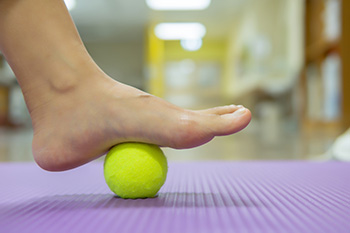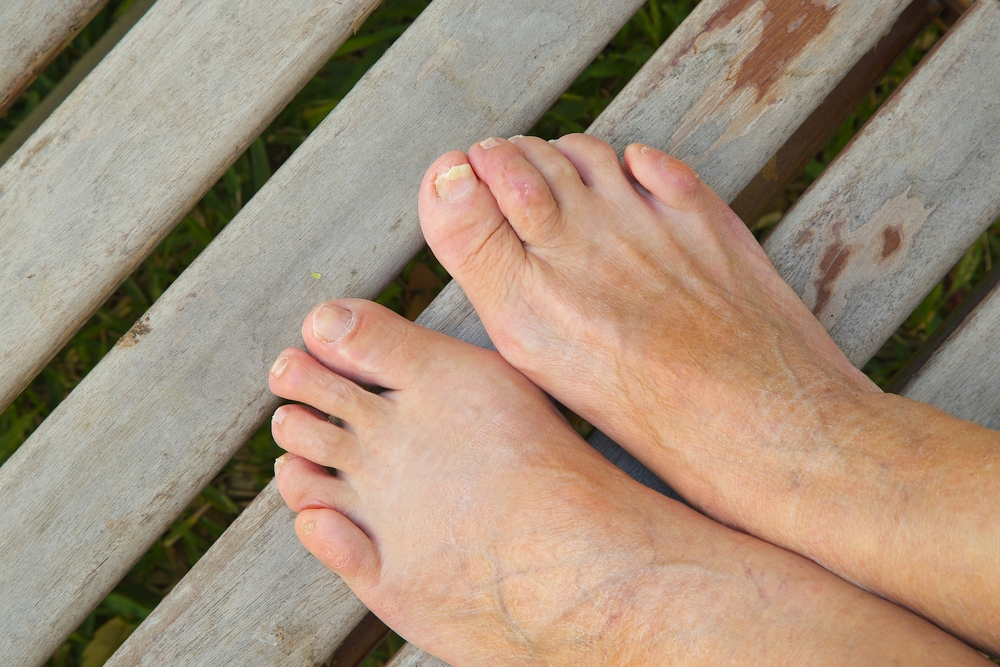Yakima
(509) 225-3668
Ellensburg
(509) 925-4633

The health of our feet can play a significant role in increasing the efficacy and ease of our physical exercises and workouts. Interestingly, our feet can largely influence other parts of the human body and their performance during yoga sessions. Yoga is a popular form of exercise that disciplines the mind, body, and spirit through the practice of different yoga poses. When an individual engages in yoga with healthy feet, this can positively impact the tone of the pelvic floor. This is because the feet are linked with and mirror the pelvic floor during yoga sessions. Additionally, yoga enthusiasts who have strong and resilient feet can strengthen their perineal muscles. Needless to say, those who practice yoga can reap many benefits from simply strengthening their feet. Contact a podiatrist today for more information about this subject.
Exercising your feet regularly with the proper foot wear is a great way to prevent injuries and build strength. If you have any concerns about your feet, contact one of our podiatrists from Cascade Foot & Ankle. Our doctors can provide the care you need to keep you pain-free and on your feet.
Exercise for Your Feet
Exercise for your feet can help you gain strength, mobility and flexibility in your feet. They say that strengthening your feet can be just as rewarding as strengthening another part of the body. Your feet are very important, and we often forget about them in our daily tasks. But it is because of our feet that are we able to get going and do what we need to. For those of us fortunate enough to not have any foot problems, it is an important gesture to take care of them to ensure good health in the long run.
Some foot health exercises can include ankle pumps, tip-toeing, toe rises, lifting off the floor doing reps and sets, and flexing the toes. It is best to speak with Our doctors to determine an appropriate regimen for your needs. Everyone’s needs and bodies are different, and the activities required to maintain strength in the feet vary from individual to individual.
Once you get into a routine of doing regular exercise, you may notice a difference in your feet and how strong they may become.
If you have any questions please feel free to contact our offices located in Yakima and Ellensburg, WA . We offer the newest diagnostic and treatment technologies for all your foot and ankle needs.

There is a portion of tissue on the bottom of the foot that is called the plantar fascia. It connects the heel to the toes and is instrumental in helping the foot flex while walking, running, and completing other daily activities. An injury may cause the plantar fascia to tear, possibly resulting in plantar fasciitis. It may also occur from overuse that can happen from running or standing on uneven surfaces. Plantar fasciitis is an inflammation that can cause severe pain and discomfort, and may affect the Achilles tendon in the calf. It may also be caused by wearing shoes that do not fit correctly, having an abnormal foot structure, or from weight that has been gained. Common symptoms may include foot pain after sitting or standing for a long period of time, and difficulty in climbing the steps. Additionally, the pain may be more severe after arising in the morning, as the first few steps are taken. If you have foot pain, it is strongly urged that you are under the care of a podiatrist who can accurately diagnose plantar fasciitis, and guide you toward the correct treatment techniques.
Plantar fasciitis can be very painful and inconvenient. If you are experiencing heel pain or symptoms of plantar fasciitis, contact one of our podiatrists from Cascade Foot & Ankle. Our doctors can provide the care you need to keep you pain-free and on your feet.
What Is Plantar Fasciitis?
Plantar fasciitis is the inflammation of the thick band of tissue that runs along the bottom of your foot, known as the plantar fascia, and causes mild to severe heel pain.
What Causes Plantar Fasciitis?
How Can It Be Treated?
While very treatable, plantar fasciitis is definitely not something that should be ignored. Especially in severe cases, speaking to your doctor right away is highly recommended to avoid complications and severe heel pain. Your podiatrist can work with you to provide the appropriate treatment options tailored to your condition.
If you have any questions please feel free to contact our offices located in Yakima and Ellensburg, WA . We offer the newest diagnostic and treatment technologies for all your foot and ankle needs.

Hammertoe is a foot condition that causes the toes to jut upward at the joint. Typically, the toe will point upwards at the middle joint. Hammertoe is distinct but similar to a related foot condition that is known as claw toe. Hammertoe and claw toe are similar because they both affect the toes of the feet. Claw toe causes an individual’s toes to curl underneath their feet. However, they differ in that hammertoe causes part of the toe to point upwards, while claw toe causes the toes to point or curl downwards. There are two types of claw toe: flexible and rigid claw toe. Flexible claw toe is the earlier phase of the condition when the toes still remain flexible. However, rigid claw toe is typically the later phase of this condition where the toes are no longer flexible. If you are concerned about hammertoe or claw toe, contact a podiatrist today.
Hammertoe
Hammertoes can be a painful condition to live with. For more information, contact one of our podiatrists from Cascade Foot & Ankle. Our doctors will answer any of your foot- and ankle-related questions.
Hammertoe is a foot deformity that affects the joints of the second, third, fourth, or fifth toes of your feet. It is a painful foot condition in which these toes curl and arch up, which can often lead to pain when wearing footwear.
Symptoms
Causes
Genetics – People who are genetically predisposed to hammertoe are often more susceptible
Arthritis – Because arthritis affects the joints in your toes, further deformities stemming from arthritis can occur
Trauma – Direct trauma to the toes could potentially lead to hammertoe
Ill-fitting shoes – Undue pressure on the front of the toes from ill-fitting shoes can potentially lead to the development of hammertoe
Treatment
Orthotics – Custom made inserts can be used to help relieve pressure placed on the toes and therefore relieve some of the pain associated with it
Medications – Oral medications such as anti-inflammatories or NSAIDs could be used to treat the pain and inflammation hammertoes causes. Injections of corticosteroids are also sometimes used
Surgery – In more severe cases where the hammertoes have become more rigid, foot surgery is a potential option
If you have any questions please contact our offices located in Yakima and Ellensburg, WA . We offer the newest diagnostic and treatment technologies for all your foot and ankle needs.

A bunion is a detrimental foot condition that can develop on the side of the big toe. Bunions can form either in response to a genetic disposition towards bunions or in response to foot injuries. Wearing narrow shoes frequently can also result in the development of bunions. Many individuals who are curious about learning more about this condition often wonder what exactly bunions look like and what their normal size is. Bunions are shaped like a bony lump, bulge, or bump. This lump is typically located at the point where the joint is located in the toe. Bunions can come in many different sizes. Regular bunions typically form on the side of the big toe. However, smaller bunions are also possible as well. For example, bunions that are smaller in size are known as bunionettes and can form on the side of the pinky or little toe. If you are interested in learning more about bunion shapes and sizes, contact a podiatrist today who will be able to help answer your questions.
If you are suffering from bunions, contact one of our podiatrists of Cascade Foot & Ankle. Our doctors can provide the care you need to keep you pain-free and on your feet.
What Is a Bunion?
A bunion is formed of swollen tissue or an enlargement of boney growth, usually located at the base joint of the toe that connects to the foot. The swelling occurs due to the bones in the big toe shifting inward, which impacts the other toes of the foot. This causes the area around the base of the big toe to become inflamed and painful.
Why Do Bunions Form?
Genetics – Susceptibility to bunions are often hereditary
Stress on the feet – Poorly fitted and uncomfortable footwear that places stress on feet, such as heels, can worsen existing bunions
How Are Bunions Diagnosed?
Doctors often perform two tests – blood tests and x-rays – when trying to diagnose bunions, especially in the early stages of development. Blood tests help determine if the foot pain is being caused by something else, such as arthritis, while x-rays provide a clear picture of your bone structure to your doctor.
How Are Bunions Treated?
If you have any questions, please feel free to contact our offices located in Yakima and Ellensburg, WA . We offer the newest diagnostic and treatment technologies for all your foot care needs.

Senior citizens are particularly at risk of experiencing complications in their foot health. This is due to several reasons, most of which involve the diminishing health and resilience of the feet among senior citizens. One of the most important parts of caring for the feet as a senior includes choosing to listen to the feet when they are trying to tell you that something is wrong. Often, if the feet are feeling painful, it is always the more cautious option to not ignore signs of pain. If you are a senior citizen, it can be important to remind yourself that having painful feet or sore feet is not an inevitable part of growing older. If you think that your feet are trying to tell you that something is not right, take this seriously and do not ignore any signs. If you are experiencing foot pain as a senior citizen, contact a podiatrist today. By meeting with a podiatrist, you can help draw up a plan to address any pain in the feet.
Proper foot care is something many older adults forget to consider. If you have any concerns about your feet and ankles, contact one of our podiatrists from Cascade Foot & Ankle. Our doctors can provide the care you need to keep you pain-free and on your feet.
The Elderly and Their Feet
As we age we start to notice many changes in our body, but the elder population may not notice them right away. Medical conditions may prevent the elderly to take notice of their foot health right away. Poor vision is a lead contributor to not taking action for the elderly.
Common Conditions
Susceptible Infections
Diabetes and poor circulation can cause general loss of sensitivity over the years, turning a simple cut into a serious issue.
If you have any questions please feel free to contact our offices located in Yakima and Ellensburg, WA . We offer the newest diagnostic and treatment technologies for all your foot and ankle needs.